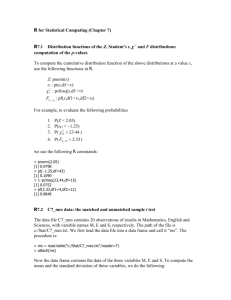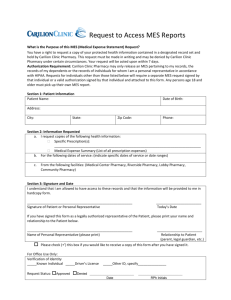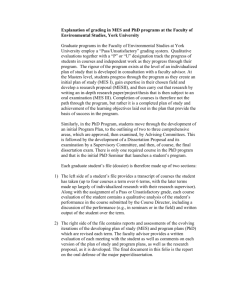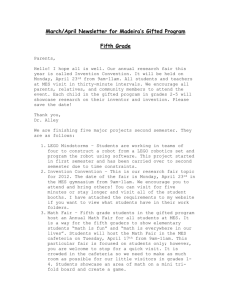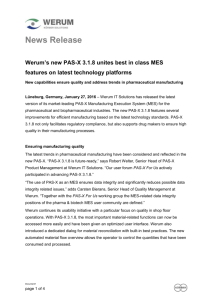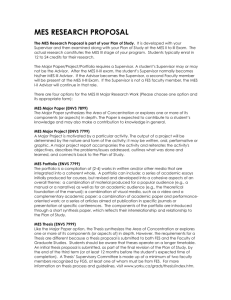Understanding Manufacturing Execution
advertisement
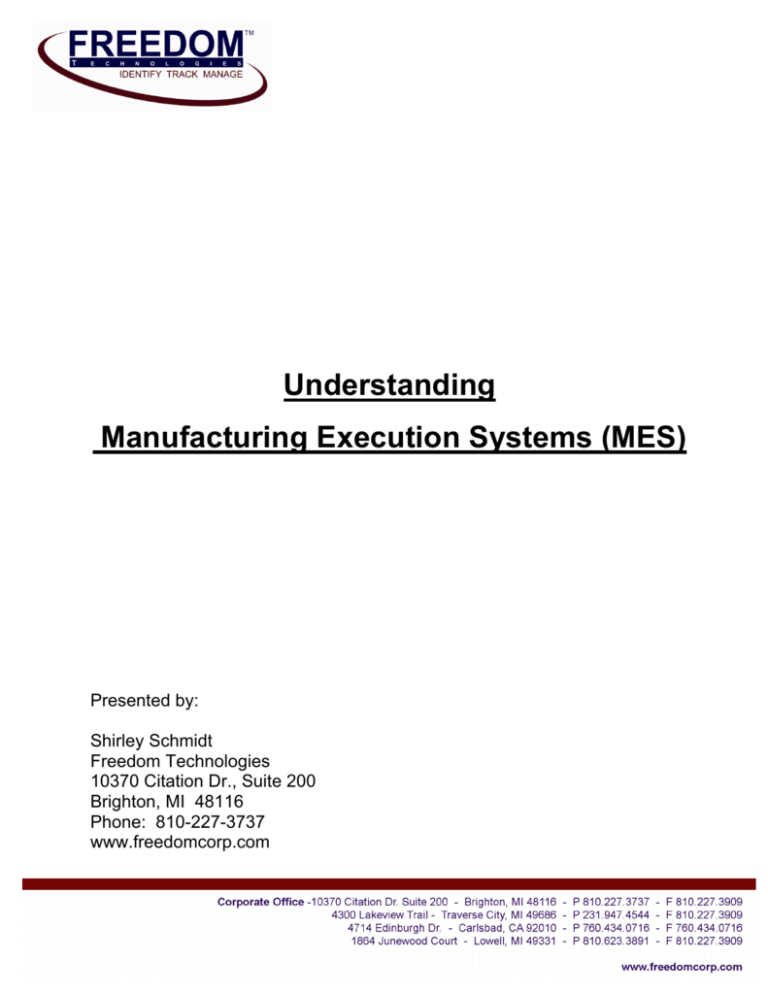
Understanding Manufacturing Execution Systems (MES) Presented by: Shirley Schmidt Freedom Technologies 10370 Citation Dr., Suite 200 Brighton, MI 48116 Phone: 810-227-3737 www.freedomcorp.com What is a Manufacturing Execution System (MES)? AMR Research, a Boston-based industry and market analysis firm, defines a Manufacturing Executing System (MES) as “a functional layer of information technology that links business planning and shop floor control systems to deliver to manufacturing an achievable and realistic production plan.” To help understand AMR’s explanation the term shop floor control system should be defined as: “A system for using data from the shop floor to maintain and communicate status information on shop orders (manufacturing orders) and on work centers. Shop floor control can use order control or flow control to monitor material movement through the facility. The major sub-functions of shop floor control are: 1. Assigning priority of each shop order 2. Maintaining work-in-process quantity information 3. Conveying shop order status information to the office 4. Providing actual output data for capacity control purposes 5. Providing quantity by location by shop order for work-in-process inventory and accounting purposes 6. Providing measurement of efficiency, utilization, and productivity of the workforce and machines. The major sub-functions for flow control are based primarily on production rates and feeding work into production to meet these planned rates, then monitoring and controlling production.” (APICS Dictionary, 12th Edition) It may appear that an MES is a relatively new class of system, although it is has been around for 15+ years awareness of MES continues to grow as the rate of acceptance increases. The adoption of MES has expanded as companies realize MES is used to evaluate and manage production activities using the latest technologies to support traceability, monitoring, and management of shop floor activities. It can be confusing to obtain an exact description of MES in that many designations are perceived to fill the Manufacturing Execution space, such as: Shop floor execution systems, supply chain execution system, manufacturing operations management, assembly management systems, plant floor visibility solution, enterprise production system, and data collection solutions. However, MES is a distinct functional group, not to be confused with systems that only address one or two aspects of a complete MES system. Central to an MES is the “execution” aspect, as in Manufacturing Execution System versus “planning”, as in Enterprise Planning. As in all ventures planning has its significance, however planning without execution is ineffectual. An MES is not one single simple application. An effective MES consists of an integrated set of production activity and support applications that have been developed using correctly matched technologies. With so many components creating an MES, implementing an MES in a variety of degrees becomes possible; from uncomplicated WIP tracking to a solution integrated throughout a plant floor collecting data, monitoring, and managing resources while co-existing with other systems such as Enterprise Resource Planning (ERP), Product Lifecycle Management (PLM), and Supervisory Control And Data Acquisition (SCADA). The real key to understanding an MES is to be aware that it simply automates the information loop between the shop floor and enterprise information systems. An MES makes up-to-the minute shop floor information available companywide, which allows a swift response to conditions and requirements. Bottom line, MES is the ideal application to collect data needed by any other system in the organization, providing a real-time database for traceability while providing information for continuous improvement in operations. Why Consider a Manufacturing Execution System (MES) Today’s intense economic conditions favor manufacturers who can do more with less and do it faster, better and more cost effectively. Manufacturers are experiencing rising material and overhead costs and are looking for ways to implement lean processes and better visibility of the shop floor, including quicker turnarounds which keep inventory low. To assist manufacturers in accomplishing this, an MES offers a foundation of realtime data and details for continuous improvement and decision support. Current economics continue to influence manufacturing toward shorter and smaller production runs with more stress on quality and complex regulatory requirements. An MES offers access to real-time shop floor information to allow quick and timely responses to any challenge that could negatively influence efficiency, quality and regulatory compliance. There is one certainty, that good data is required to get good information. An MES system supplies that “good data” by offering uninterrupted visibility into production operations, gaining a complete overall view of the shop floor. Unlike an ERP that measures transactions in terms of days, weeks and months, an MES measures movement on the shop floor in terms of hours, minutes and seconds. With the robust approach an MES offers, manufacturers are able to capture and manage data to make mission critical decisions and react in a timely manner throughout an organization. Functionalities of a Manufacturing Execution System (MES) MES compliments the capabilities of an ERP, helping to leverage an organization’s ERP investment. Both systems collectively supply information, which creates more accurate schedules resulting in realistic production plans, shorter cycle times, less WIP and lower inventory. MES also provides the shop floor control and visibility needed to effectively deal with multifaceted traceability requirements. Using real-time “good data” from automated transactions collected from the shop floor, MES links supplier information, lot numbers, serial numbers, time/date or other records to the appropriate finished goods, back to the work order or demand signal. MES not only provides production people with accurate information so they can schedule precisely, but also offers an electronic network for performance improvement. The following is a list of 11 functionalities of an MES system as described by the Manufacturing Execution Solution Association (MESA) International: MESA International – 11 Detailed MES Functions Function 1. Resource Allocation and Status 2. Operations/ Detail Scheduling Description Manages resources including machines, tools labor skills, materials, other equipment, and other entities such as documents that must be available in order for work to start at the operation. It provides detailed history of resources and insures that equipment is properly set up for processing and provides status real time. The management of these resources includes reservation and dispatching to meet operation scheduling objectives. Provides sequencing based on priorities, attributes, characteristics, and/or recipes associated with specific production units at an operation such as shape of color sequencing or other characteristics which, when scheduled in sequence properly, minimize setup. It is finite and it recognizes alternative and overlapping/ parallel operations in order to calculate in detail exact time or equipment loading and adjust to shift patterns. 3. Dispatching Production Units Manages flow of production units in the form of jobs, orders, batches, lots, and work orders. Dispatch information is presented in sequence in which the work needs to be done and changes in real time as events occur on the factory floor. It has the ability to alter prescribed schedule on the factory floor. Rework and salvage processes are available, as well as the ability to control the amount of work in process at any point with buffer management. 4. Document Control Controls records/forms that must be maintained with the production unit, including work instructions, recipes, drawings, standard operation procedures, part programs, batch records, engineering change notices, shift-to-shift communication, as well as the ability to edit “as planned” and “as built” information. It sends instructions down to the operations, including providing data to operators or recipes to device controls. It would also include the control and integrity of environmental, health and safety regulations, and ISO information such as Corrective Action procedures. Storage of historical data. 5. Data Collection/ Acquisition This function provides an interface link to obtain the intra-operational production and parametric data which populate the forms and records which were attached to the production unit. The data may be collected from the factory floor either manually or automatically from equipment in an up-to-the-minute time frame. 6. Labor Management Provides status of personnel in and up-to-the-minute time frame. Includes time and attendance reporting, certification tracking, as well as the ability to track indirect activities such as material preparation or tool room work as a basis for activity based costing. It may interact with resource allocation to determine optimal assignments. 7. Quality Management Provides real time analysis of measurements collected from manufacturing to assure proper product quality control and to identify problems requiring attention. It may recommend action to correct the problem, including correlating the symptom, actions and results to determine the cause. May include SPC/SQC tracking and management of off-line inspection operations and analysis in laboratory information management system (LIMS) could also be included. Monitors production and either automatically corrects or provides decision support to operators for correcting and improving in-process activities. These activities may be intra-operational and focus specifically on machines or equipment being monitored and controlled as well as inter-operational, which is tracking the process from one operation to the next. It may include alarm management to make sure factory person(s) are aware of process changes which are outside acceptable tolerances. It provides interfaces between intelligent equipment and MES possible through Data Collection/Acquisition. Tracks and directs the activities to maintain the equipment and tools to insure their availability for manufacturing and insure scheduling for periodic or preventive maintenance as well as the response (alarms) to immediate problems. It maintains a history of past events or problems to aide in diagnosing problems. Provides the visibility to where work is at all times and its disposition. Status information may include who is working on it; components materials by supplier, lot, serial number, current production conditions, and any alarms, rework, or other exceptions related to the product. The on-line tracking function creates a historical record, as well. This record allows traceability of components and usage of each end product. Provides up-to-the-minute reporting of actual manufacturing operations results along with the comparison to past history and expected business result. Performance results include such measurements as resource utilization, resource availability, product unit cycle time, conformance to schedule and performance to standards. May include SPC/SQL. Draws on information gathered from different functions that measure operating parameters. These results may be prepared as a report or presented online as current evaluation of performance. 8. Process Management 9. Maintenance Management 10. Product Tracking and Genealogy 11. Performance Analysis Source: MESA (Manufacturing Execution Solutions Association) International Benefits of Implementing a Manufacturing Execution System (MES) Depending on what questions a manufacturer is seeking quick answers to; the benefits of MES are many and varied. An MES is capable of tracking genealogy from the shop floor throughout a product’s life cycle and processing the data into information that can be used by management immediately to identify issues and allow real-time adjustments to operations, supplier material resolution and streamline recalls. Some of the key benefits and capabilities an MES provides are to: • Effectively deal with complex genealogy and traceability requirements, using automated transactions from shop floor workers and machines to tie lot numbers, serial numbers or other data to the appropriate finished goods back to the work order. • Efficiently trim down scrap and waste through real time production reporting and limit the number of bad parts and wasted material. • Eliminate equipment downtime and successfully increase uptime by having access to up-to-the-minute scheduling of machines, resources and machine maintenance. • Reduce the cost of recalls by using track and trace capabilities to trace back to each incoming lot, subassembly, and part or item used; and after locating the start of a problem track out to the current location of all end products experiencing the problem. There are many benefits that can be experienced through the implementation of an MES and together all of these benefits allow a manufacturer to realize major productivity improvements, improve customer satisfaction and obtain an overall competitive advantage in the marketplace. About Freedom Technologies Freedom Technologies is a complete identification, tracking, and data management solution provider. Freedom Technologies’ solutions meet traceability guidelines for the automotive, medical and military industries. Error Proof® also extends itself as a robust Manufacturing Execution System (MES) to manage and monitor shop floor operations. Since 1991, companies have been seamlessly integrating Freedom Technologies' Error Proof® and ID ADVANTAGE™ software with their new or existing hardware and systems. By offering software applications designed for monitoring, managing and controlling production line operations, Freedom Technologies ensures the accuracy of the manufacturing and shipping procedures. In conjunction with our applications, Freedom Technologies offers UID/direct part mark readers, vision verification systems, lasers and RFID solutions. For more information, please visit www.freedomcorp.com.
